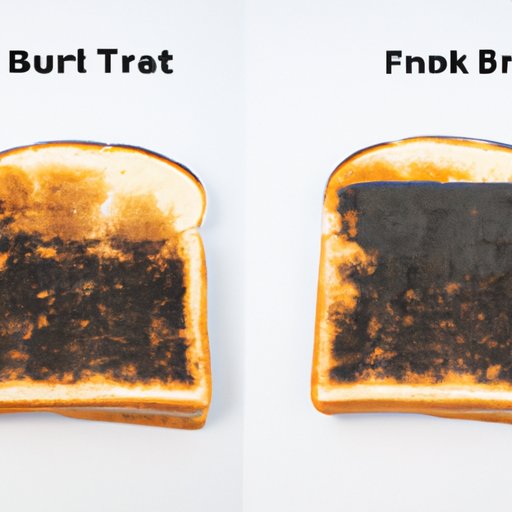
Introduction
Bread is a staple in many households, but sometimes, we end up with more than we can consume before it goes stale. Freezing bread is an excellent way to extend its shelf life, but how long can you freeze bread? In this article, we will explore the optimal length of time to freeze bread, tips for proper packaging and storage, how to thaw frozen bread, potential risks and drawbacks of freezing bread, creative uses for frozen bread, expert advice on determining whether frozen bread is safe to eat, and recommendations for the best types of bread to freeze.
Optimal Length of Time to Freeze Bread
The freezer can preserve bread for a long time, but the length of time it remains fresh depends on several factors, such as the type of bread, packaging, and storage. As a general rule, bread can last up to six months in the freezer without significant loss in quality. However, it would be best to consume it within three months for optimal freshness.
Here’s how long you can freeze different types of bread:
- White bread: 2-3 months
- Whole wheat bread: 3-4 months
- Rye bread: 2-3 months
- Sourdough bread: 4-6 months
- Bread rolls: 2-3 months
To maintain freshness, you must place the bread in a vacuum-sealed bag or airtight container before freezing. This helps to prevent moisture build-up and freezer burn. You should also label the packaging with the date of freezing to avoid confusion later.
Tips for Thawing Frozen Bread
Thawing bread is a delicate process that requires some finesse to prevent the bread from losing its texture and flavor. Here are some different methods for thawing bread:
- Microwave: This is the fastest way to defrost bread, but it can also result in soggy or dry bread. To prevent that, wrap the bread in a damp paper towel and microwave it on low power for several seconds, flipping the bread over halfway.
- Room temperature: This method requires patience but results in the best texture and flavor. Place the bread on a plate and leave it on the counter to thaw. Avoid direct sunlight or heat sources that can cause uneven thawing.
Whether you choose to use the microwave or room temperature, removing the bread from its packaging gradually an hour before thawing helps to prevent condensation and loss of moisture. Avoid using hot water or a toaster oven to thaw bread, as it can cause uneven heating and unwanted texture changes.
Potential Risks and Drawbacks of Freezing Bread
While freezing bread is an excellent way to preserve it, it can also cause some unwanted changes in texture, flavor, and nutritional value. Freezing can cause the gluten in the bread to break down, resulting in a denser and chewier texture. Additionally, the moisture in the bread can migrate to the crust, resulting in a soggy texture.
However, you can minimize the risks by following proper packaging and storage procedures, or using the frozen bread for recipes that require it to be toasted or cooked.
Creative Uses for Frozen Bread
Stale or frozen bread can be put to good use in many recipes. Here are some suggestions:
- Croutons: Slice the frozen bread into cubes, toss with seasoning and olive oil and bake in the oven until crispy.
- Breadcrumbs: Pulse the frozen bread in a food processor until you get fine crumbs.
- French Toast: Perfect for stale bread, cut the bread into thick slices, dip in an egg and milk mixture, and pan fry until golden brown.
Additionally, many recipes, such as meatloaf or stuffing, require the bread to be shredded or crumbled, making frozen bread an ideal ingredient.
Expert Advice on How to Determine If Frozen Bread is Safe to Eat
The primary concern when freezing bread is whether it’s still safe to eat. Here are some signs to look for when determining the freshness of frozen bread:
- Discoloration or mold: If you notice any mold or dark spots on the bread, it’s time to discard it.
- Foul smell: If the bread smells rancid or sour, it’s best to exercise caution and discard it.
- Texture changes: If the bread is frozen for too long, it may become dry or crumbly, making it less enjoyable to eat.
When in doubt, it’s best to err on the side of caution and discard the bread.
Recommendations for Best Types of Bread to Freeze and How to Prepare them for Optimal Results
Not all types of bread freeze well. Here are some types of bread that retain their texture and flavor after thawing:
- White and wheat sandwich bread
- Bagels
- Pita bread
- Focaccia bread
Before freezing, slice the bread to the desired thickness and wrap each slice individually with plastic wrap. Then, place them in an airtight container or vacuum-sealed bag.
Conclusion
Freezing bread is an excellent way to save money and reduce food waste, but it’s essential to do it right. To recap, you should freeze bread no longer than six months, store it in an airtight container or vacuum-sealed bag, and thaw it gradually. Frozen bread can also be put to good use in many recipes, such as croutons, breadcrumbs, and French toast. Remember to check for signs of spoilage before eating frozen bread and discard it if in doubt. By following these tips, you can enjoy fresh, delicious bread all year round.





